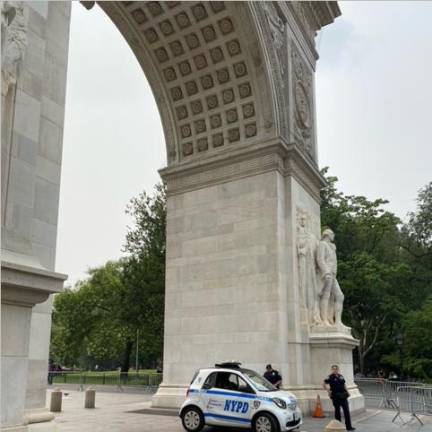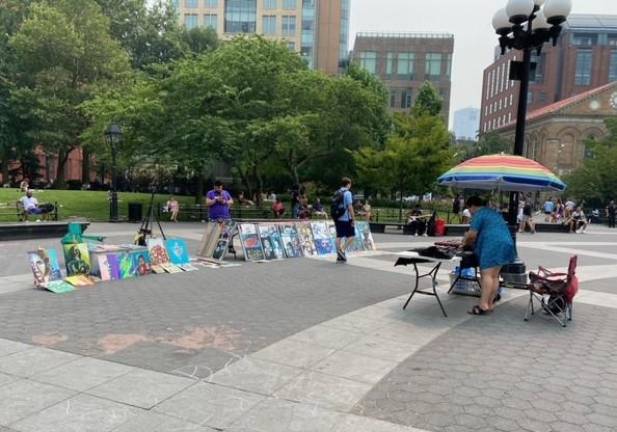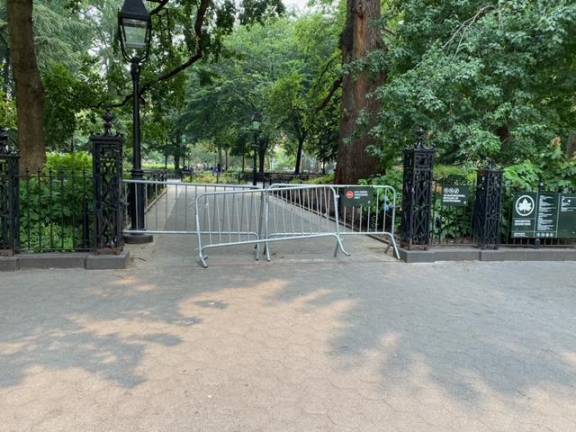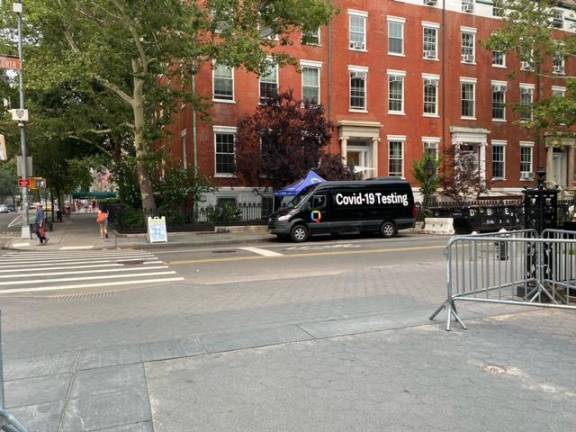A Post-Pandemic Washington Square Park
After clashes and a curfew: patrol cars, art and vendors at the iconic park in summer 2021




Skateboards clatter as tattooed teens whiz past benches filled with people resting, chatting, or simply taking in the scenes of the evening. The last glimmers of sunlight tinge the twilight sky lilac, just light enough to contrast the spray of water coming from the grand fountain in the center of the park. Along pathways, vendors are set up selling snacks, clothes, and even spontaneous poems. Under the giant archway a projector is set up, about to play a movie. It is Friday night in Washington Square Park, and everywhere is full of life.
Washington Square Park has historically been a hub of activity, attracting everyone from local dog-walkers to revelers who often hold impromptu parties under its iconic arch. As a public space, the Park offers many free events, such as barre classes, film screenings, and salsa dancing. With people desperate for social interaction after a year of lockdown and the summer weather making it hard to stay inside with no AC, these events always attract big crowds and are a part of what makes the park so special. Yet the sharp increase in people over the past few months can be a bit overwhelming, and there have been clashes between parkgoers and nearby residents. Additionally, the increase in police presence after a few especially raucous parties and resident complaints has made some wary of staying in the park, especially after dark. The temporary 10 p.m. curfew, enforced by officers, was a sign that while the park may be back in business, things aren’t as harmonious as they seem on the conservancy’s website.
Walking through the park in the early afternoon, it’s easy to look past the recent changes made by police and park officials. Barricades by the entrances are pushed to the side as people filter in and out, and only a few officers are present. It’s harder, however, to ignore the large flashing sign next to the arch, which is inaccessible due to a wide circle of metal barricades with two officers patrolling the area. The sign, similar to ones seen in traffic or roadblocks, blares messages such as “no skating” or “park closes at 12 am,” the latter being a nod to the ending of the 10 p.m. curfew.
Police maintain that protection of the arch is necessary. “People were vandalizing all over the arch,” said one of the officers inside the barricade, explaining why the area was closed off. The issue of vandalism, and overall park cleanliness and safety, raises questions about who the park is meant for and how much freedom to give to its visitors. Preventing vandalism is essential to maintaining park property, but closing off large swaths of said property may defeat the purpose of preserving it for pedestrians. Other areas of Washington Square Park are also closed off to the public, such as the tables in the northwest corner. This area, home to the conservancy’s Art in the Park weekly event, has only been open for the event, with park officials telling people to leave afterwards and find other areas to sit.
The number of patrol cars and officers increases as the day goes on. “No one’s really supposed to be in the park after dark,” one officer confided when asked about the curfew. Still, he noted, 12am is the official time of closing once more, and he expects it to remain so, another pre-pandemic feature of the park most likely here to stay. The presence of police even during the daytime is a new addition post-pandemic, but rules are not strictly enforced– a vendor sold THC-infused margaritas 50 feet away from the “no alcohol, no smoking” sign, and lighters flicked on and off like fireflies. Masking is also not mandatory, with none of the officers sporting a face covering, but there was a pop-up COVID testing site set up outside the park’s central north entrance.
Street vendors are another hallmark of the park, and they’re flocking back for the summer. In addition to artwork, hot dogs, or jewelry, some people set up to collect donations for foundations like the National Breast Cancer Foundation. In order to set up in the park, explained one volunteer, the foundation needs to apply for a permit. In the case of the National Breast Cancer Foundation, the permit is free because they are a nonprofit. But others selling their wares didn’t care for permits, free or not. The man selling margaritas looked almost bewildered when asked if he needed a permit, as if it was a trick question.
“Look around,” he said, gesturing to the several other stands around the fountain. “Everyone can just set up.” And it’s true: no one batted an eye at any of the vendors around the fountain, except for those interested in buying. This laissez-faire attitude toward park business is what makes it such a hot spot, and it looks like this, at least, is here to stay.